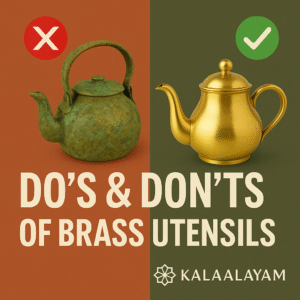
Brass utensils have been a staple in Indian kitchens for centuries. Known for their golden shine and durability, they also offer health and cultural benefits. However, brass can react with certain foods if not used correctly. Here’s a comprehensive guide on the dos and don’ts, as well as the chemical reactions of brass in the kitchen, helping you use it safely and effectively.
Do’s of Using Brass
1. Always Tin (Kalai) Brass Cookware – Brass cookware should be coated with tin (kalai) to prevent harmful reactions with food.
2. Use for Water and Dry Storage – Ideal for storing water, grains, and ghee due to natural antimicrobial properties.
3. Use for Ritual Foods and Dairy Products – Safe for serving milk, ghee, sweets, and prasad when tinned.
4. Regular Cleaning – Clean brass items with natural cleansers like lemon, tamarind, or vinegar with salt.
5. Polish Periodically – Keep utensils shiny and functional with routine polishing.
Don’ts of Using Brass
1. Avoid Acidic Foods – Do not cook or serve tamarind, tomatoes, curd, or lemon-based foods in uncoated brass.
2. Don’t Store Liquids for Long – Water, juices, or sour liquids can cause corrosion if stored in raw brass for long periods.
3. Don’t Scrub with Harsh Chemicals – Strong detergents or abrasive scrubbers damage the tin coating.
4. Don’t Overheat Empty Brass Cookware – Heating without food or liquid can damage the kalai coating.
Chemical Reactions of Brass in the Kitchen
• With Acidic Foods – Brass reacts with acidic foods to form copper and zinc salts, which are toxic in excess.
• With Moisture – Moisture and air can create a greenish layer (verdigris: copper carbonate + acetate), which is poisonous.
• With Tin Coating – Tin (kalai) is chemically stable and prevents reactions, making periodic re-coating essential.
Final Thoughts
Brass is safe, beneficial, and eco-friendly when used the right way. The key is proper maintenance and tin-coating. For water storage, ritual foods, and dairy, brass is an excellent choice. But avoid using it with acidic foods unless properly coated. By following these do’s and don’ts, you can enjoy the health benefits of brass utensils while preserving tradition.
